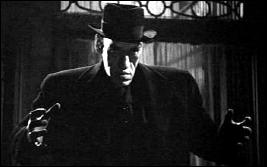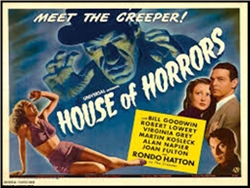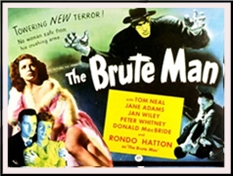Wed 30 Sep 2020
UNIVERSAL’S CREEPER SERIES: Three Movie Reviews by Dan Stumpf.
Posted by Steve under Horror movies , Reviews[5] Comments
Three Movie Reviews by Dan Stumpf.
THE PEARL OF DEATH. Universal, 1944. Basil Rathbone (Sherlock Holmes), Nigel Bruce (Doctor Watson), Dennis Hoey (Inspector Lestrade), Evelyn Ankers, Rondo Hatton.
Based on the characters created by Sir Arthur Conan Doyle. Director: Roy William Neill.

HOUSE OF HORRORS . Universal, 1946. Robert Lowery, Virginia Grey, Bill Goodwin, Martin Kosleck, Alan Napier, Virginia Christine, Howard Freeman, Joan Shawlee and Rondo Hatton. Screenplay by George Bricker & Dwight V. Babcock. Directed by Jean Yarborough.
THE BRUTE MAN. Universal/PRC, 1946. Rondo Hatton, Tom Neal, Jan Wiley, Jane Adams. Screenplay by George Bricker and M Coates Webster, from a story by Dwight V Babcock. Directed by Jean Yarbrough.
Universal is fondly remembered as the home of Frankenstein, Dracula, the Wolfman, and other classic horrors, but they had their share of misfires too. Kharis was more wet blanket than monster, no one could decide what Paula the Ape Woman looked like, the Mad Ghoul stalled out early…
And then there was The Creeper.

A certain amount of controversy has attached to Rondo Hatton, some seeing him as a victim of crass exploitation, others as a man who willingly used his misfortune as best he could. Scott Gallinghouse’s perceptive biography (RONDO HATTON: Beauty Within the Brute, Bear Manor, 2019) paints a picture of a man who enjoyed his brief and tenuous stardom, was celebrated in his home town, and played it up, entertaining guests, and visiting wounded GIs in Army Hospitals.
Hatton played bits and extras in Hollywood for years until someone spotted him for a choice part in PEARL OF DEATH (1944: reviewed here ) a superior entry in the Sherlock Holmes series which used Hatton sparingly and to eerie effect as “The Hoxton Creeper†a hulking, silent, spine-snapping killer.
Finding a new Horror Star dropped in their laps, Universal slipped him into JUNGLE CAPTIVE (1945) and THE SPIDER WOMAN STRIKES BACK (1946, a spin-off from the Sherlock Holmes series, with Gale Sondergaard) then somebody looked back at PEARL OF DEATH and decided it was impressive enough for Universal to launch a series, produced by Ben Pivar (of the Mummy movies) who brought his own working-class perspective and lack of interest to bear, with the usual tepid results.

Pivar’s series kicked off with HOUSE OF HORRORS and a better-than-average cast. Alan Napier does a dead-on Waldo Lydecker impression as an art critic, and Howard Freeman is even better as his effeminate replacement. Top honors, however, must go to Martin Kosleckd sculptor.
Kosleck occupied a niche in horror movies somewhere between Peter Lorre and Dwight Frye, and his greatest moment came in HOUSE OF HORRORS, as a demented sculptor at odds with the Art World, who sends the Creeper out to murder his critics — an idea that recalls various versions of THE GOLEM. Kosleck’s art isn’t much good, but it is sort of interesting, and I’d like to see how his style might have developed… but any semblance of atmosphere is dispelled as soon as Rondo Hatton opens his mouth to speak and there is just No Talent here. It wouldn’t have taken much brains to write a script where the Creeper stays silent – just some interest and maybe a little imagination – but that was obviously more than Pivar wanted to invest.

THE BRUTE MAN, released later the same year, is even tackier and less interesting. Hatton died soon after it wrapped, and Universal, with tastefulness rare for them, decided not to release it. Instead, they sold it to PRC (an even cheaper studio) who put it out as part of their steady trickle of sub-B flicks. Historians of both studios (and there are some) usually use this as an excuse not to discuss BRUTE MAN, which is probably the kindest cut of all.
I have to say, though, that BRUTE and HORRORS set their monster loose amid flophouses, tenements and seedy second-hand stores, bad as they are (and maybe because of Ben Pivar’s penny-squeezing) these movies evoke that seamy background kind of effectively; it’s like David Goodis wrote a monster movie.
Strictly as an aside, imagine my surprise when I saw Rondo Hatton and Elena Verdugo, the campy Gypsy Girl in HOUSE OF FRANKENSTEIN, in a classy movie like THE MOON AND SIXPENCE (1942) which just goes to show what a many-splendored thing The Movies is.

September 30th, 2020 at 7:47 pm
There is something nice about his being in a film like SIXPENCE. It somehow feels right that his entire career wasn’t spent in films like BRUTE MAN.
HORRORS is almost a good film, but we always have PEARL.
September 30th, 2020 at 9:17 pm
Rondo Hatton earned a better than average living, so the opinionated social justice warriors should shut the hell up, unless they are or were ready to match his money. Oh, it is show business, we are all exploited. Handsome guys, fat men, and girls with good bodies — there is no conscription in the arts.
October 1st, 2020 at 12:39 am
Re Martin Kosleck. In 1945 Edgar Ulmer directed a lovely second feature called The Wife of Monte Cristo. Lenore Aubert played Haydee, John Loder the handsome villain De Villefort and Martin a fascinating Edmond Dantes bringing to the screen, and for perhaps the only time, a performance that suggests the life Dumas described. Well worth a look
October 1st, 2020 at 4:12 am
Barry, WIFE OF MONTE CRISTO has its moments. I particularly recall one where a carriage races past a stately building and the pillars flap in the wind.
October 2nd, 2020 at 8:01 pm
Barry, ditto regarding WIFE OF MONTE CARLO.